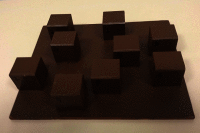Are ventrolateral and dorsolateral prefrontal cortices involved in the computerized Corsi block-tapping test execution? An fNIRS study
- PMID: 29376100
- PMCID: PMC5774174
- DOI: 10.1117/1.NPh.5.1.011019
Are ventrolateral and dorsolateral prefrontal cortices involved in the computerized Corsi block-tapping test execution? An fNIRS study
Abstract
The Corsi block-tapping test (CBT) is an old neuropsychological test that, requiring the storage and the reproduction of spatial locations, assesses spatial working memory (WM). Despite its wide use in clinical practice, the specific contribution of prefrontal cortex (PFC) subregions during CBT execution has not been clarified yet. Considering the importance of spatial WM in daily life and the well-known role of ventrolateral-PFC/dorsolateral-PFC (VLPFC/DLPFC) in WM processes, the present study was aimed at investigating, by a 20-channel functional near-infrared spectroscopy (fNIRS) system (including four short-separation channels), the hemodynamic response of the VLPFC/DLPFC during a computerized version of the CBT. Thirty-nine university students were asked to perform CBT standard version (CBTs), block-suppression CBT (CBTb), and control task (CBTc). A VLPFC activation during CBTs and a DLPFC activation during CBTb were hypothesized. The results of the Bayesian analysis have not shown a delineated specific activation of VLPFC/DLPFC during either CBTs or CBTb. These results together with the related ones obtained by others using fMRI are not sufficient to definitively state the role of the PFC subregions during CBT execution. The adoption of high-density diffuse optical tomography would be helpful in further exploration of the PFC involvement in spatial WM tasks.
Keywords: Corsi block-tapping test; dorsolateral prefrontal cortex; fNIRS; ventrolateral prefrontal cortex; working memory.
Figures






References
-
- Baddeley A. D., Hitch G., Bower G. A., “Working memory,” in Recent Advances in Learning and Motivation, Academic Press, New York: (1974).
LinkOut - more resources
Full Text Sources
Other Literature Sources
Miscellaneous

